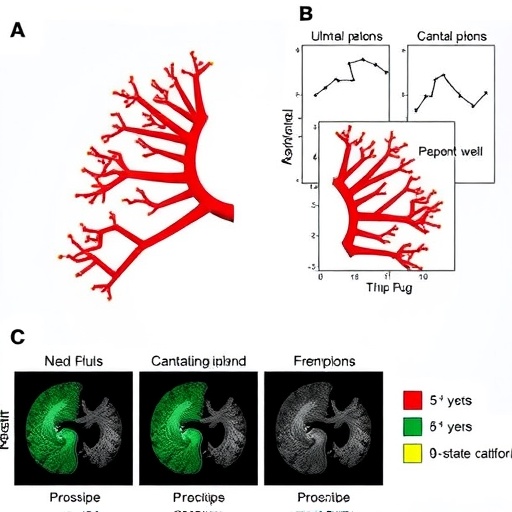In a groundbreaking advancement at the nexus of artificial intelligence and oncology, researchers have unveiled a novel computational framework that significantly elevates the precision of predicting prostate cancer patients’ response to hormonal therapy. This innovative methodology, called the Multi-branch CNNFormer, merges the strengths of Convolutional Neural Networks (CNNs) and Vision Transformers (ViTs) within a unified deep learning architecture, addressing longstanding limitations in medical image analysis and clinical outcome forecasting.
Prostate cancer remains one of the most prevalent malignancies among men worldwide, and hormonal therapy is a principal treatment modality aimed at halting disease progression. However, predicting therapeutic efficacy on a per-patient basis poses a formidable challenge, often handicapped by variability in tumor biology and limited sensitivity of conventional imaging assessments. The newly proposed Multi-branch CNNFormer framework harnesses multi-modality magnetic resonance imaging (MRI) combined with the clinical biomarker prostate-specific antigen (PSA) to discern nuanced tumor responses, offering a more personalized and accurate prediction model.
Central to this approach is the integration of 3D convolutional neural networks with 3D Vision Transformers, each branch contributing complementary yet distinct advantages. CNNs excel at capturing local structural features in volumetric medical images, maintaining rich spatial resolution critical for precise tumor localization. Conversely, ViTs enable the extraction of global contextual information by modeling long-range dependencies across the image volume—a task where traditional CNNs often falter due to their inherent locality bias. By fusing these paradigms, the CNNFormer achieves a holistic feature representation that encapsulates both detailed anatomical insights and overarching spatial relations within prostate lesions.
Technically, the 3D CNN component functions to encode volumetric MRI scans into high-level features, preserving the intricate spatial patterns vital for discerning subtle morphological changes indicative of therapy response. Meanwhile, the 3D ViT branch employs self-attention mechanisms tailored to volumetric data, enabling the model to reason about the global structure and interactions within the imaging data. This multi-branch design mitigates the typical pitfalls associated with ViTs—particularly their loss of fine-grained localization through repeated downsampling—while simultaneously overcoming CNNs’ limited receptive field.
The research was conducted on a cohort of 39 prostate cancer patients, stratified by their PSA biomarker profiles to enrich the diversity of biological responses captured. Despite the modest sample size, the Multi-branch CNNFormer demonstrated exceptional predictive performance, achieving an accuracy of 97.50%, with perfect sensitivity at 100% and a specificity of 95.83%. These metrics underscore the model’s robust capability to correctly identify both responders and non-responders to hormonal therapy, marking a substantial improvement over existing predictive models that often struggle with either sensitivity or specificity.
This advancement portends significant clinical implications. By enabling highly accurate pre-treatment predictions, oncologists can tailor therapeutic strategies more effectively, sparing patients unlikely to benefit from hormonal therapy the side effects while promptly identifying those most likely to respond. Furthermore, the model’s reliance on standard clinical imaging modalities and the PSA marker aligns well with current diagnostic workflows, facilitating potential integration into routine practice without necessitating extraordinary resources.
Beyond its immediate application in prostate cancer, the conceptual framework pioneered by the Multi-branch CNNFormer offers a versatile template for tackling similar challenges across other cancer types and medical conditions where treatment response is heterogeneous and difficult to predict. The synergy between CNNs’ spatial acuity and ViTs’ global contextual understanding may chart a new direction for deep learning models in precision medicine, particularly in volumetric imaging analysis.
The study also addresses a critical methodological bottleneck in the use of ViTs for medical imaging. Traditional ViT architectures require multiple downsampling layers that compromise the resolution of spatial features, an issue that this multi-branch architecture cleverly circumvents by preserving high-fidelity localization through the CNN pathway. This strategy enables the model to maintain detailed anatomical information essential for differentiating subtle image changes resulting from hormonal interventions.
Complementing the imaging data, the inclusion of PSA biomarker status provided an additional layer of biological context, further empowering the model’s predictive capacity. PSA, a routinely measured indicator in prostate cancer management, augments the imaging features with systemic information reflecting tumor burden and activity. This multimodal data fusion is emblematic of the increasing trend in AI-powered diagnostics to combine heterogeneous clinical data for richer, more accurate insights.
The promising outcomes of this research are particularly notable given the challenges associated with small cohort sizes, which often limit the generalizability of AI models in medical domains. Achieving such high accuracy with just 39 patients indicates a strong potential for scalability and adaptation, although further validation with larger and more diverse populations is warranted to fully establish clinical utility.
In conclusion, the Multi-branch CNNFormer represents a significant leap forward in the intelligent prediction of prostate cancer treatment response. By integrating the complementary benefits of CNNs and ViTs, this framework deftly navigates the complexities of volumetric medical imaging and clinical biomarker data to deliver robust, high-precision forecasts. Such technological innovations not only promise to refine therapeutic decision-making but also herald a new era of data-driven personalized medicine in oncology and beyond.
As deep learning continues to evolve, the success of models like CNNFormer exemplifies the transformative potential of hybrid architectures that bridge the gap between localized feature extraction and global contextual understanding. Future research building on this foundation may extend to multimodal multi-omics data, real-time monitoring, and adaptive treatment protocols, further cementing AI’s role as an indispensable ally in combating cancer.
Subject of Research: Predicting prostate cancer response to hormonal therapy using a combined CNN and Vision Transformer model integrating multi-modality MRI and PSA biomarker data.
Article Title: Multi-branch CNNFormer: a novel framework for predicting prostate cancer response to hormonal therapy.
Article References:
Abdelhalim, I., Badawy, M.A., Abou El-Ghar, M. et al. Multi-branch CNNFormer: a novel framework for predicting prostate cancer response to hormonal therapy. BioMed Eng OnLine 23, 131 (2024). https://doi.org/10.1186/s12938-024-01325-w
Image Credits: AI Generated




